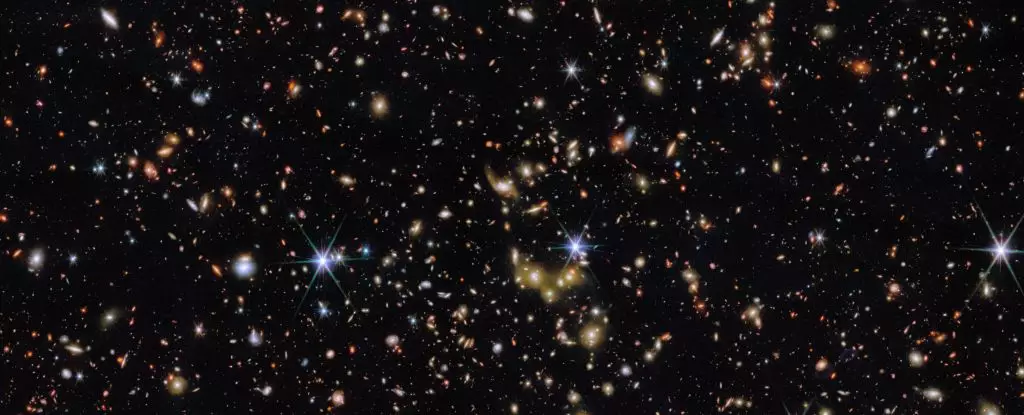The James Webb Space Telescope (JWST) continues to astonish humanity with its breathtaking revelations about the cosmos. In one of its most eye-opening captures, the telescope has focused on a minute section of the night sky, revealing a staggering array of lights that are predominantly galaxies rather than mere stars. This deep field image, which peers back nearly 12 billion years, transforms a seemingly ordinary patch of sky into a vibrant tapestry of cosmic history. The sheer magnitude of this discovery is humbling; it forces us to reckon with the monumental scale of the universe and our relatively minuscule place within it.
As we gaze at this new image, we encounter myriad “lights” that, upon closer inspection, manifest as galaxies—an assertion underlined by the striking diffraction spikes that the JWST produces. Unlike the scattered twinkling of stars familiar to our night sky, these galaxies shine without such artistic embellishments, suggesting their vast distances and colossal sizes. Every dot hints at a collection of billions of stars, each potentially hosting its own planetary systems. The mind races with wonder—what kinds of worlds exist in these distant realms, and are they anything like our own?
A Gateway to Cosmic Evolution
At the forefront of this particular JWST image is a captivating cluster of galaxies, casting a warm, golden luminescence that harkens back 6.5 billion years. This is nearly half the age of the known universe, challenging our perspective on time and existence. The hunt for understanding the formation and evolution of such galaxy groups lies at the heart of the COSMOS-Web survey. By cataloging galaxy clusters, scientists can piece together the intricate puzzle of cosmic evolution—how matter has organized itself into the structures we observe today.
Moreover, we find ourselves not only fascinated by the galaxies themselves but also by the invisible forces that bind them together—dark matter and hydrogen, which congregate in an unseen cosmic web. Unlike many layman approaches that view the universe as a chaotic agglomeration, these clusters reveal a profound order underpinning the cosmos. There’s a deep philosophy embedded in this; the universe, far from being a haphazard collection of stars and galaxies, works in systematic ways governed by the laws of physics. This echoes profound thoughts on the nature of existence and our ongoing quest for understanding.
The Significance of an “Ordinary” Patch of Sky
The most astonishing aspect of this image comes from the realization that it doesn’t represent an isolated instance; rather, it serves as a microcosm for the whole universe. The survey conducted by astronomers led by Greta Toni identifies an incredible 1,678 clusters of galaxies within this minute section of space. This signifies that if we were to randomly examine other areas of the sky, we would unveil equally riveting discoveries—an ocean of galaxies glimmering in areas smaller than our pinky nail.
To comprehend this overwhelming abundance of cosmic entities is to confront the very essence of existence. While a mere fraction of the sky yields such an astounding quantity of galaxy groups, we are encouraged to think about what lies beyond the visible; countless regions await exploration. The implications are tantalizing and portentous—each glance upward might reveal not just stars, but the building blocks of unknown galaxies waiting to be charted and cataloged.
Awe and Responsibility
As we marvel at the brilliance of this JWST image, a sense of responsibility also arises. With knowledge comes power, and with power, we must engage with ethical considerations grounded in our exploration of the cosmos. What should we do with this knowledge of the universe’s vastness? How do we protect our own planet and species within it while promoting a greater cosmic consciousness? The JWST provides a lens not only to explore the universe but also to reflect on our own stewardship of Earth.
In essence, the revelations from the JWST not only underline the grandeur of the universe but also compel us to think more deeply about our role within it. As we stand on the precipice of discovery, gazing into the depths of space, we must ask ourselves: how do we proceed as stewards of our own planet, while embracing the infinite possibilities that the cosmos presents? The answers lie ahead, waiting to be uncovered, much like the galaxies that await our persistent curiosity.

